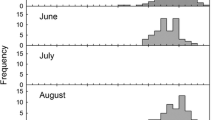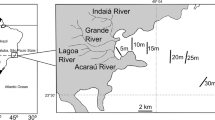Abstract
Using a hand dredge, a population of Cassidulus mitis Krau, 1954 was sampled monthly from February 1986 to January 1987 at 15 stations offshore from Vermelha Beach (22°57′18″ S; 43°9′48″ W), in water depths ranging from 0 to 6 m. The sex ratio indicated a slight numerical dominance of females for adults and a larger numerical female dominance for juveniles. A von Bertalanffy growth curve was estimated as L=71.00 (1-e(-0.390t)), where L=length (mm) and t=time (yr). The instantaneous natural mortality rate (M) was estimated as 0.812. The population occupies a zone parallel to the beach, and displays a spatially aggregated pattern, with higher densities in areas characterized by coarse and very well sorted sand containing low amounts of organic matter.
Similar content being viewed by others
Literature cited
Batthacharya, C. G. (1967). A simple method of resolution of a distribution into Gaussian components. Biometrics 23: 115–135
Bauer, J. C. (1976). Growth, aggregation and maturation in the echinoid Diadema antillarum. Bull. mar. Sci. 26: 273–277
Bertalanffy, L., von (1938). A quantitative theory of organic growth. Hum Biol. 10: 181–213
Beukema, J. J. (1985). Growth and dynamics in populations of Echinocardium cordatum in living in the North Sea off the Dutch north coast. Neth. J. Sea Res. 19: 129–134
Beverton, R. J. H., Holt, S. J. (1957). On the dynamics of exploited fish populations. Fish. Invest., Lond. 19: 1–533
Birkeland, C., Chia, F. S. (1971). Recruitment risk, growth, age and predation in two populations of sand dollars, Dendraster excentricus (Eschscholtz). J. exp. mar. Biol. Ecol. 6: 265–278
Brower, J. E., Zar, J. H. (1977). Field and laboratory methods for general ecology. W. C. Brown Co., Dubuque, Iowa
Buchanan, J. B. (1966). The biology of Echinocardium cordatum (Echinodermata: Spatangoidea) from different habitats. J. mar. biol. Ass. U.K. 46: 97–114
Campbell, R. C. (1974). Statistics for biologists. 2 edn. Cambridge University Press, Cambridge
Chesher, R. H. (1969). Contributions to the biology of Meoma ventricosa (Echinoidea: Spatangoida). Bull. mar. Sci. 19: 72–110
Dexter, D. M. (1977). A natural history of the sand dollar Encope stokesi L. Agassiz in Panama. Bull. mar. Sci. 27: 544–551
Ebert, T. A. (1975). Growth and mortality of post-larval echinoids. Am. Zool. 15: 755–775
Ebert, T. A. (1982). Longevity, life history, and relative body wall size in sea urchins. Ecol. Monogr. 52: 353–394
Ebert, T. A., Dexter, D. M. (1975). A natural history study of Encope grandis and Mellita grantii, two sand dollars in the northern Gulf of California, Mexico. Mar. Biol. 32: 397–407
Elliott, J. M. (1977). Some methods for the statistical analysis of samples of benthic invertebrates. Scient. Publs Freshwat. biol. Ass. 25: 1–257
Folk, R. L., Ward, W. C. (1957). Brazos River bar: a study in the significance of grain size parameters. J. sedim. Petrol. 27: 3–26
Gayanilo, F. C., Jr, Soriano, M., Pauly, D. (1989). A draft guide to the Compleat ELEFAN. ICLARM Software 2: 1–67
Gladfelter, W. B. (1978). General ecology of the cassiduloid urchin Cassidulus caribbearum. Mar. Biol. 47: 149–160
Higgins, R. C. (1974). Observations on the biology of Apatopygus recens (Echinoidea: Cassiduloida) around New Zealand. J. Zool., Lond. 173: 505–516
Moore, H. B., Jutare, T., Bauer, J. C., Jones, J. A. (1963). The biology of Lytechinus variegatus. Bull. mar. Sci. Gulf Caribb. 13: 23–53
Pauly, D. (1984). Fish population dynamics in tropical waters: a manual for use with programmable calculators. ICLARM Stud. Rev. 8: 1–325
Pauly, D., Caddy, J. (1985). A modification of Batthacharya's method for the separation of normal distributions. F.A.O. Fish. Circ. 781: 1–16 (+ errata sheet)
Suguio, K. (1973). Introdução à sedimentologia. Edgar Blucher Ltd, São Paulo
Tahara, Y., Okada, M., Kobayashi, N. (1958) Secondary sexual characters in Japanese sea-urchins. Publs Seto mar. biol. Lab. 7: 165–172, 8 pls
Tommasi, L. R., Lima-Verde, J. S. (1970). Observações sobre Cassidulus mitis Krau, 1954 (Cassiduloida, Echinoidea). Bolm Inst. Oceanogr., S Paulo 18: 1–9
Weihe, S. C., Gray, I. E. (1968). Observations on the biology of the sand dollar Mellita quinquiesperforata (Leske). J. Elisha Mitchell scient. Soc. 84: 315–327
Author information
Authors and Affiliations
Additional information
Communicated by J. M. Lawrence, Tampa
Rights and permissions
About this article
Cite this article
Freire, C.A., Santos, P.J.P., Fontoura, N.F. et al. Growth and spatial distribution of Cassidulus mitis (Echinodermata: Echinoidea) on a sandy beach in Southeastern Brazil. Marine Biology 112, 625–630 (1992). https://doi.org/10.1007/BF00346180
Accepted:
Issue Date:
DOI: https://doi.org/10.1007/BF00346180




